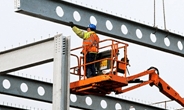Steel Markets

AGC: Construction Costs Down in December, But Up for the Year
Written by Sandy Williams
January 15, 2019
Construction costs declined in December after a year of price spikes, but remained higher than a year ago, said the chief economist for the Associated General Contractors of America.
“Steep declines in fuel prices in December offset mixed costs for other construction inputs, but most materials and services posted higher year-over-year increases than in 2017,” said AGC’s Ken Simonson in an analysis of government data. “The price index for new building construction outpaced the input cost index at the end of the year, but many contractors were probably caught by unexpected cost increases in 2018.”
The producer price index for goods and services used in construction decreased 0.8 percent in December, but was 3.8 percent higher than in December 2017. Although energy costs declined 11.5 percent for the month and 3.9 percent for the year, prices for other goods used in construction climbed 0.1 percent for the month and 4.8 percent for the year, commented Simonson. The component of the index tracking services purchased by contractors also increased, rising 0.4 percent in December and 4.2 percent for the year. The increases for goods and services followed 2017 gains of 3.3 percent and 3.7 percent, respectively.
Contractor charges for construction of new nonresidential buildings were unchanged for the month, but 5.3 percent higher than a year ago.
Association officials said higher construction prices will increase the cost of many public infrastructure projects and could undermine the financial viability of new private-sector development projects. They urged Washington officials to resolve trade disputes that have led to new and threatened tariffs on a host of construction materials. They also called for comprehensive immigration reform and new federal investments in career and technical education to prepare and recruit more people into the construction industry.
“Public officials may be forced to scale back planned infrastructure projects to cope with higher costs, while many privately financed projects may no longer pencil out if construction costs continue to increase,” said Stephen E. Sandherr, the association’s chief executive officer. “Resolving costly trade disputes and addressing labor shortages will help relieve much of the inflationary pressure on construction costs.”

Sandy Williams
Read more from Sandy WilliamsLatest in Steel Markets

CMC looks beyond Arizona micro-mill woes to long-term viability of construction mart
Despite the economic and geopolitical upheaval of the last five years, CMC President and CEO Peter Matt points out that the construction market has been an essential element of the way forward.

US importers face stricter rules under revamped S232 tariffs
“CBP expects full compliance from the trade community for accurate reporting and payment of the additional duties. CBP will take enforcement action on non-compliance," the agency said in a March 7 bulletin.

Steel exports rebound in January
US steel exports recovered to a five-month high in January after having fallen to a two-year low in December. This growth follows four consecutive months of declining exports.

Construction spending drops marginally in January
Construction spending edged down slightly in January, slipping for the first time in four months. The US Census Bureau estimated spending at a seasonally adjusted annual rate of $2,196 billion in January, down 0.2% from December’s downward revised rate. The January figure is 3.3% higher than a year ago. January’s result, despite the slight erosion, […]

HVAC equipment shipments slow in December but strong annually
Shipments of heating and cooling equipment in the US fell to an 11-month low in December, according to the latest data released by the Air-Conditioning, Heating, and Refrigeration Institute (AHRI).
